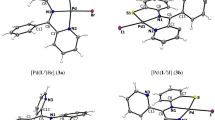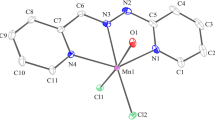Summary
Coordination compounds formed by the interaction of some bivalent metal halides and pseudohalides with the potentially bidentate ligands, 3-picolylamine and 4-picolyl-amine, have been prepared and characterized by molecular conductance, magnetic susceptibility, electronic and i.r. spectral measurements in the solid state. The i.r. spectral studies indicate that, in addition to their monodentate bonding through pyridine ring nitrogens, these ligands also bond through their amino nitrogen and, in some cases, act as bidentate bridging or chelating ligands. Tentative stereochemistries of the complexes isolated in the solid state are discussed. The ligand field parameters 10 Dq, B, Dq/B,β andv 2/v 1 are calculated for the cobalt(II) and nickel(II) complexes and are consistent with their proposed stereochemistries.
Similar content being viewed by others
References
G. J. Sutton,Austral. J. Cbem., 13, 74, 473 (1960);14, 33, 37, 545, 550 (1961);15, 232, 563 (1962);16, 1134 (1963);19, 733 (1969); R. G. Lacoste and A. E. Martell,Inorg. Chem., 3, 881 (1964); S. Utsuno and K. Sone,Bull. Chem. Soc. Japan, 37, 1038 (1964); S. Utsuno,J. Inorg. Nucl. Chem., 28, 2647 (1966); J. J. Sirola and R. O. Ragsdale,Inorg. Chem., 4, 760 (1965); F. Holmes and D. R. Williams,J. Chem. Soc. A, 1256, 1702 (1967); G. A. Renovitch and W.A. Baker Jr.,J. Am. Chem. Soc., 89, 6377 (1967); F. G. Nasouri, M. W. Blackmore and R. J. Magee,Austral. J. Chem., 20, 1291 (1967); L. El-Sayed and R. O. Ragsdale,Inorg. Chem., 6, 1640 (1967); R. Syamal,Inorg. Nucl. Chem. Lett., 4, 625 (1968);Curr. Sci., 37, 69 (1968);J. Ind. Chem. Soc., 45, 343 (1968); R. S. P. Coults and P. C. Wailes,Austral. J. Chem., 21, 2199 (1968); A. R. Nicholson and G. J. Sutton,Austral. J. Chem. 22, 59, 373, 1543 (1969); E. Uhlig and E. Gottschleng, Z.Anorg. Allg. Chem., 376, 113 (1970); A. Earnshaw, L. F. Larkworthy and K. C. Patel,J. Chem. Soc. A, 1840 (1970).
C. H. Cline and J. Turkevich,J. Chem. Phys., 12, 300 (1953); J. K. Wilmshurst and H. J. Bernstein,Can. J. Chem., 35, 1171 (1957); D. A. Long, F. S. Murfin and E. L. Thomas,Trans. Faraday Soc., 59, 12 (1963).
G. W. Watt, B. B. Hutchinson and D. S. Klett,J. Am. Chem. Soc., 89, 2007 (1967).
N. S. Gill, R. H. Nuttall, D. E. Scaife and D. W. A. Sharp,J. Inorg. Nucl. Chem., 18, 79 (1961).
I. S. Ahuja and Raghuvir Singh,J. Coord. Chem., 4, 181 (1975).
C. K. Jorgensen,Absorption Spectra and Chemical Bonding in Complexes, Pergamon Press, London, 1962.
E. Konig,Structure & Bonding, 9, 175 (1971).
R. J. H. Clark in V. Gutmann (Ed.),Halogen Chemistry, Vol. 3, Academic Press, New York, 1968.
I. S. Ahuja and Rajindar Singh,J. Inorg. Nucl. Chem., 35, 302 (1973).
G. E. Coates and D. Ridley,J. Chem. Soc., 166 (1964).
R. A. Bailey, S. L. Kozak, T. W. Michelsen and W. N. Mills,Coord. Chem. Revs., 6, 407 (1970).
A. D. Liehr and C. J. Ballhausen,Ann. Phys. N.Y., 6, 134 (1959).
I. S. Ahuja and Raghuvir Singh,Inorg. Nucl. Chem. Lett., 10, 421 (1974); I. S. Ahuja and K. S. Rao,J. Inorg. Nucl. Chem., 36, 586 (1975); I. S. Ahuja, Raghuvir Singh and C. P. Rai,J. Coord. Chem., in press.
Author information
Authors and Affiliations
Rights and permissions
About this article
Cite this article
Ahuja, I.S., Singh, R. & Sriramulu, R. 3- and 4-picolylamine complexes of bivalent metal halides and pseudohalides. Transition Met Chem 4, 65–69 (1979). https://doi.org/10.1007/BF00618826
Received:
Issue Date:
DOI: https://doi.org/10.1007/BF00618826




